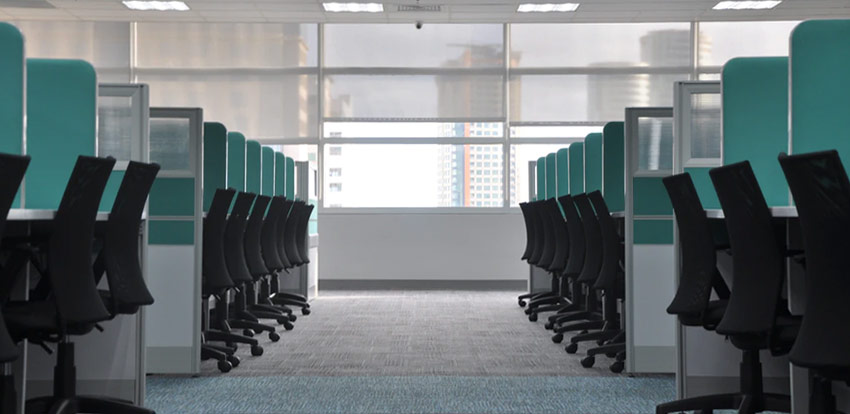
Retention remains a hot topic – one that business leaders are treating as a top priority going into 2020. Naturally, organizations want to hold on to their top performers (it’s expensive to lose them, after all). And, on the other hand, employees want to feel recognized, appreciated, and rewarded by their employers. They want to work in a motivating, positive, and healthy environment.
But, does that depend on the physical work space that they find themselves in? Does your office space design and layout impact their productivity, morale, and ultimately their will to stay and be a part of your company?
The simple answer is ‘yes’. But, we’ll dive into a few points to unpack why this is and how you can improve your work space to support your retention efforts, without necessarily having to do a complete office makeover.
The evolution of the office layout
As with most aspects of the work world, office layouts have also changed with the times. In a fascinating Reader’s Digest UK article, we see how the trend shifted from cubed seating systems in the 1980s, and ‘virtual officing’ in the 1990s, to the emergence of networking- and aesthetic-focused spaces in the 2000s and 2010s.
The effects of the modern open-plan office layout
Today, it’s rather common for organizations to have open-plan office layouts. In fact, Morten Meisner-Jensen, Co-Founder of ROOM, shares in a Forbes article that “seventy percent of offices today are open plan”. And while he believes it can be fantastic, he adds that “it really needs to be implemented correctly with employee productivity and happiness in mind”.
After all, the truth is that open-plan offices can lack privacy; they can be distracting, and loud, making it tricky (more so for some than others) to concentrate, host meetings, and complete tasks efficiently or with innovation.
Although the concept behind open-plan office space is to encourage creativity, collaboration, and a positive company culture (and in some cases, it does), this setup has the potential to lead to feelings of frustration, overwhelm, and a deflated sense of morale.
That said, whether your office layout is open plan or not, the key takeaway is that the environment that your employees are in does ultimately impact their ability to perform, to be happy, and to be well (which all influence their desire to remain a part of your company).
So, let’s take a look at how you can support your retention efforts by creating an appealing office environment.
Seven concepts for buildings that encourage employee retention
As outlined in the earlier mentioned Forbes article, and according to The WELL Building Standard (administered by the International WELL Building Institute and certified by Green Business Certification Inc.), there are seven important components to a building’s ‘performance’. These are:
- Air – Quite simply, fresh air impacts productivity positively. Companies can enhance the quality of air by introducing a ‘no-smoking policy’, installing filtration systems, opening windows, or adding some plants to the office décor.
- Water – Similarly, water plays a role in our productivity in that it affects our ability to focus and to be alert. Ensuring that your employees have safe drinking water is a must.
- Nourishment – A nutritious and balanced diet goes a long way in powering an individual, keeping them energized and focused. If your company provides any sort of catering, offering nourishing food options is a great way to contribute to your employees’ wellbeing.
- Light – Good lighting can alleviate eyestrain and headaches, and has an influence on one’s mood. Maximize natural lighting in your office space while controlling glare, and if necessary, add skylights and ensure that flickering lights are quickly replaced.
- Fitness – Exercise can sharpen our concentration, increase our energy levels, and increase our productivity. If you are able to create space for physical activity, great. If not, you might consider adding storage space for bicycles, and/or shower facilities to encourage an active lifestyle. Alternatively, adding adjustable workstations will allow employees to move more during the day.
- Comfort – Your office space should offer a level of comfort to employees. This might mean providing them with ergonomic furniture, sit-stand desks, different areas to work from during the day, creative spaces (read our blog on curiosity and innovation here), or quiet zones.
- Mind – Natural features play a role in enhancing our overall wellbeing, productivity, and creativity. Adding greenery to your office, or outdoor spaces are two ways of introducing natural features. But, you could also allow flexible working which allows employees the chance to work from an inspiring setting of their choice.
Implementing some of design-friendly features may mean making an investment, but when it comes to retaining your top performers, the return will likely be greater than the cost. As we’ve just seen, however, not all of the positive changes you make need to be expensive. They might just be the difference between your top performers choosing to stay or to look for greener pastures.
Does your office layout encourage retention?
Have you taken office layout into consideration, in light of your retention strategy? What has worked well, and what do you aim to improve? Let us know your thoughts on LinkedIn.
Talk to us about your talent management needs, and let us show you how to further boost retention with technology on your side.